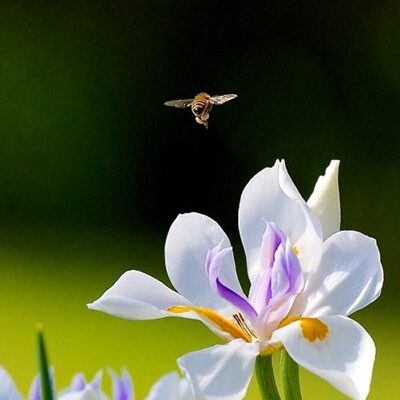How to Grow Aloe Vera Plant: Best Tips
Aloe vera is a familiar plant to most of us, known for its gel-like sap that has been traditionally used for sunburn relief and is a common ingredient in various skincare and haircare products. The plant itself is highly regarded as a decorative indoor plant due to its distinctive appearance, characterized by upright succulent leaves that are green with white spots. Aloe vera possesses fleshy leaves that store water and have a thick, waxy surface, preventing them from drying out. These characteristics enable aloe vera plants to thrive in arid conditions, making them suitable for indoor cultivation. Discover the essential guidelines for growing and nurturing an aloe vera plant, ensuring a readily available supply of soothing gel.
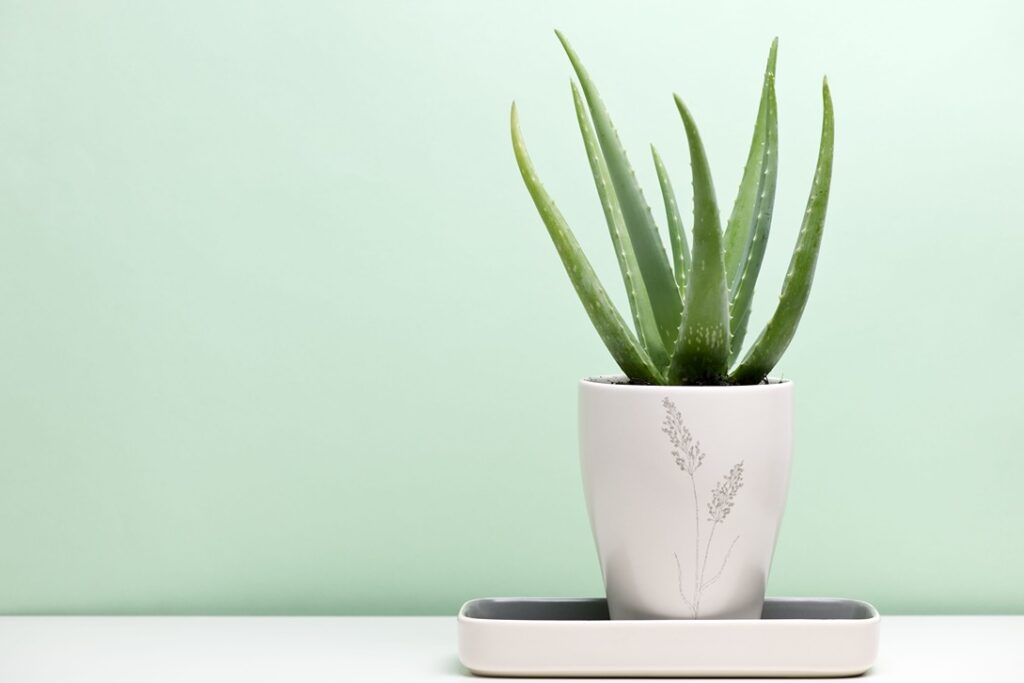
Caring for Aloe Vera Plants
In the majority of regions, aloe vera is cultivated as an indoor houseplant. During the summer, it can be moved outdoors, and in the warmest areas, it can be grown outside all year as a perennial. Aloe vera thrives in naturally hot and arid environments, which provides valuable insights into its care requirements. These plants are exceptionally low-maintenance and simple to grow as houseplants.

Light Requirements
Aloe vera flourishes when exposed to bright, direct or indirect light, although it can tolerate some shade and still thrive as an indoor plant near a well-lit window. To ensure uniform growth, it is recommended to periodically rotate indoor aloe vera plants. Full sun is necessary for aloe plants to bloom, but this outcome is more likely to be observed in outdoor settings where the plants are grown year-round.
Soil Requirements
When cultivating aloe vera as a houseplant, it is recommended to use a sandy, well-draining commercial mix specifically designed for cacti. If a standard mix is being used, it is advisable to incorporate equal parts sand and potting soil. It is best to avoid potting mixes that already contain fertilizer. In outdoor settings, aloe vera plants can tolerate poor soil conditions but still require proper drainage for optimal growth.
Watering Guidelines
Aloe vera exhibits a high level of drought tolerance. It is recommended to water these plants sparingly, allowing the top one to two inches of soil to fully dry between waterings. Ensure that the containers have proper drainage to prevent waterlogging, and avoid letting the plants remain in trays filled with water. If the plants are moved outdoors, it is advisable to position them in a sheltered spot to protect them from excessive rainfall. During the winter months when aloe vera plants are less active, it is recommended to reduce watering.
Temperature and Humidity Requirements
Aloe vera is well-suited to arid environments resembling deserts, where there is a noticeable contrast between daytime and nighttime temperatures. To replicate these conditions indoors, it is advisable to find a suitable spot, such as a windowsill, that experiences such temperature fluctuations. Aloe vera plants can sustain damage when exposed to temperatures below 40˚F (4˚C). It is recommended to wait until spring, when nighttime temperatures consistently stay above 50˚F (10˚C), before moving the plants outdoors. Similarly, in autumn, it is advisable to bring the plants back indoors before nighttime temperatures drop below this threshold. While aloe vera can thrive in humid outdoor locations, there is no specific need for humidity control when growing them indoors.
Fertilizer Usage
Aloe plants have modest fertilizer requirements. It is sufficient to apply a balanced houseplant fertilizer, diluted to half strength, once a month during the active growth period (spring to summer). It is recommended to limit fertilizer applications to a maximum of three times per year.
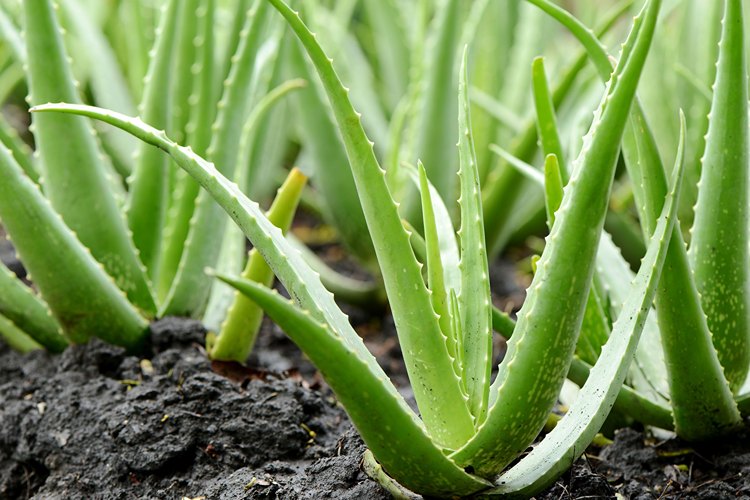
Types of Aloe Vera
Unlike many decorative plants, there are no cultivated varieties of aloe vera available. The aloe plants found at garden centers are the pure species, Aloe vera. However, the Aloe genus comprises over 400 species, offering a wide range of options. If you intend to harvest gel from the plant, it is advisable to stick with the Aloe vera species. Gardeners residing in warm climates may consider adding ornamental aloe species or hybrids to their gardens. Many varieties are also well-suited for container cultivation.
Aloe Varieties for Indoor Cultivation
Not everyone has the ideal climate for growing aloe in their gardens, but that’s not a problem. Numerous aloe species thrive when grown in containers, both indoors and outdoors during the summer.
- ‘Crosby’s Prolific’ Aloe is a miniature aloe variety that is perfect for small pots on windowsills. With a height ranging from 6 to 12 inches, this aloe forms densely packed rosettes of spiky green foliage adorned with white speckles. When exposed to bright sunlight, the foliage takes on rich red tones.
- The captivating Aloe polyphylla is sought after for its captivating spiral foliage. Its rows of blue-green leaves, arranged in perfect spiral patterns, are sure to captivate your attention.
- ‘Christmas Carol’ Aloe is another diminutive hybrid, reaching a height and width of only 6 to 10 inches. The gray-green leaves of this stylish variety feature reddish-orange edges and develop red-orange spots. The intensity of the coloration increases with brighter sunlight.
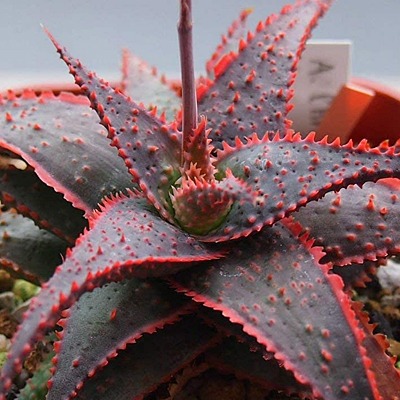
Cold Hardy Aloe Varieties for Cooler Gardens
There are several aloe species that exhibit cold hardiness and can be successfully grown outdoors in USDA hardiness Zones 8 through 11. These plants thrive in soil that is lean and well-drained.
- Aloe brevifolia is a small-sized species that typically reaches heights of 1 to 2 feet and spreads to a similar width. Its thick foliage forms rosettes, creating a vibrant carpet of colors including pale blue, coral pink, and yellow. The show is further enhanced by orange blooms during the spring.
- Aloe aristrata, a compact and ground-hugging aloe, showcases an adorable appearance with speckled leaves in white. However, don’t be deceived by its cuteness, as this aloe species is remarkably hardy.
- Let’s not forget that Aloe Vera itself is hardy up to Zone 8 and can be successfully grown outdoors in temperate regions.

Aloe Varieties for Striking Blooms
If you desire stunning blooms to enhance your garden, the following aloe species are excellent choices:
- Aloe arborescens, also known as torch aloe, is a popular aloe species due to its striking red flowers. Under suitable conditions, this species can form clumps reaching 8 to 10 feet in height.
- ‘Moonglow’ Aloe boasts remarkable flower displays. This long-blooming hybrid produces numerous inflorescences in shades ranging from yellow to salmon, which are highly attractive to hummingbirds. It can reach a size of 5 feet in height and width, making a bold statement in the garden.
- ‘Safari Sunrise’ Aloe is a compact hybrid that blooms in its first season, making it suitable for gardeners in cooler regions to plant as an annual (it can be overwintered indoors if desired). In warmer locations, it forms clumps that are 2 to 3 feet in size. The blooms of this variety showcase a variety of hues.
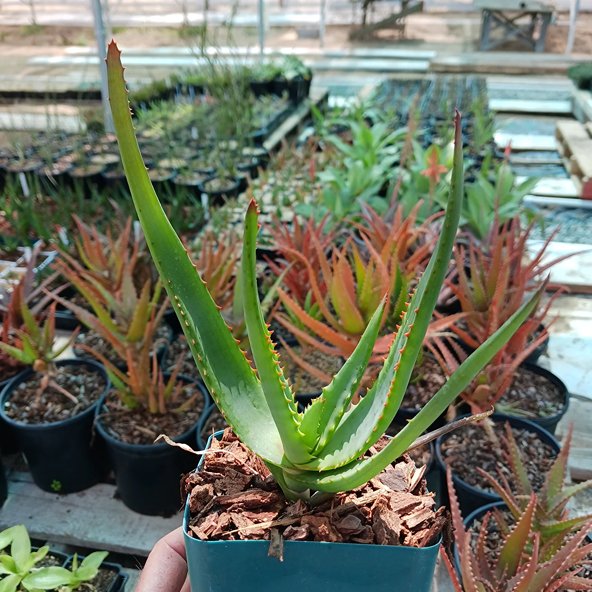
Growing Aloe Vera from Nursery Containers
Aloe Vera plants are readily available at nurseries, home and garden centers, and even grocery stores, and they can be found in various sizes. Typically, these plants are initially potted in plastic containers, which can become unstable as the plant grows. To ensure stability, it is recommended to repot your aloe vera plant into a more secure container. The choice of soil and container is crucial for the plant’s overall health.
- Selecting a Container:
Adequate drainage is essential, so opt for a container with sufficiently large openings to allow excess water to drain. Terra cotta pots are well-suited for aloe vera as they facilitate water absorption through the container. Choose a pot size similar to the plant’s current nursery pot, and it’s ideal to select a pot that is wider than it is tall, providing ample space for growth without retaining excess moisture.
- Adding Potting Soil:
Fill the container halfway with a well-draining potting medium specifically formulated for succulents or cacti.
- Planting:
Gently remove the plant from its original container, shaking off any excess soil from the roots. Place the plant in its new container at the same depth it was growing in the nursery pot. Fill in around the roots with additional soil until the container is filled to approximately one inch below the rim. Take care not to plant the aloe too deeply, as this can promote rotting.
- Light Watering:
Unlike most plants that require a thorough watering after repotting, aloe vera benefits from a brief waiting period. Use a small amount of water to settle the plant into its new home, and then wait at least a week before watering again. This waiting period allows the plant to establish new roots.
- Routine Care:
After the waiting period, water the plant thoroughly and continue with regular care as described earlier. Delay fertilization until the plant has become well-established in its new container.

Repotting Aloe Vera Plants
Periodically repotting aloe vera plants can be beneficial to refresh the soil and provide sufficient space for growth. While aloe vera plants can tolerate crowded roots to some extent, there comes a point when repotting becomes necessary. Keep an eye on the roots for signs of overcrowding. If you notice that the roots outnumber the soil, it’s time to consider repotting. Additionally, if your aloe vera plant has grown leggy, it may require a larger container (or more exposure to light). For top-heavy plants, repotting into a larger container or dividing the plant may be necessary. It is advisable to increase the size of the new container by only one or two pot sizes, typically measured in inches, to prevent excessive soil volume in relation to the root system, which can lead to root rot.
Propagating Aloe Vera through Offsets
Aloe vera plants naturally produce side shoots or offsets known as pups as they continue to grow. These small plants can be separated from the mother plant and replanted to create new individual plants. To propagate aloe vera using this method, carefully remove the pup from the mother plant using sharp pruners, scissors, or a knife. Make sure to leave at least an inch of stem attached to the pup. Place the offset in a warm location away from direct sunlight for a couple of days, allowing the cut area to develop a callous. This callous formation acts as a protective layer, guarding the new plant against potential infections. Once the callous has formed, you can proceed to pot up the pups following the instructions mentioned earlier for new plants.
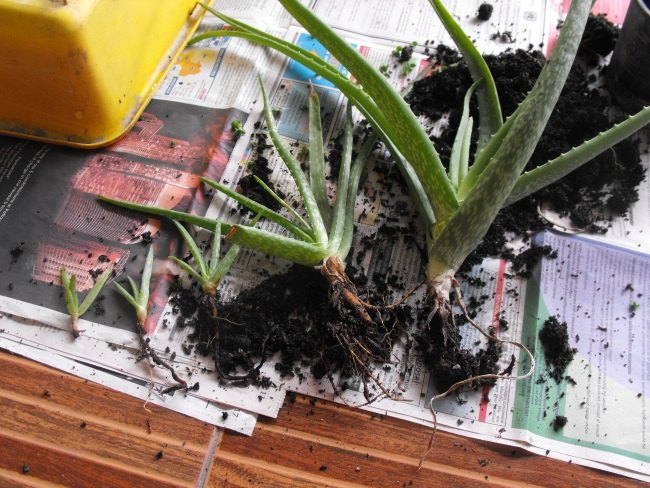
Promoting Aloe Vera Blooms
Achieving blooms with your aloe vera plants requires patience and a few steps. Keep in mind that only mature plants have the potential to bloom, and it typically takes at least four years for an aloe plant to reach that stage. Follow these guidelines to encourage blooming:
- Practice Patience
Allow your aloe vera plant to mature over time, as only adult plants have the capability to produce blooms.
- Remove Offsets
Help the mother plant direct its energy towards flowering by removing any offsets or pups growing alongside it.
- Fertilize Properly
Apply a balanced fertilizer during spring and early summer to provide essential nutrients. After fertilizing, water the plant to rinse away any excess salts. Avoid fertilizers with high phosphorous levels, as many labeled for blooming fall into this category. Follow the monthly feeding routine as described earlier.
- Provide Optimal Conditions
Aloe vera thrives in warm temperatures and abundant light for blooming. Consider moving your plant outdoors to benefit from additional sunlight. While indoor-grown plants are less likely to bloom, you can experiment by placing your plant in a very sunny location. The ideal temperature range for blooming is between 70 and 85˚F (21-29˚C). Cooler night temperatures can be beneficial, but if temperatures are predicted to drop below 60˚F (15˚C), bring the plants indoors for the night.
- Continued Care
If your aloe vera plant doesn’t produce flowers initially, continue following this routine for another year to encourage blooms in the following season. Keep pampering the plant with the recommended care to increase the likelihood of blooming.
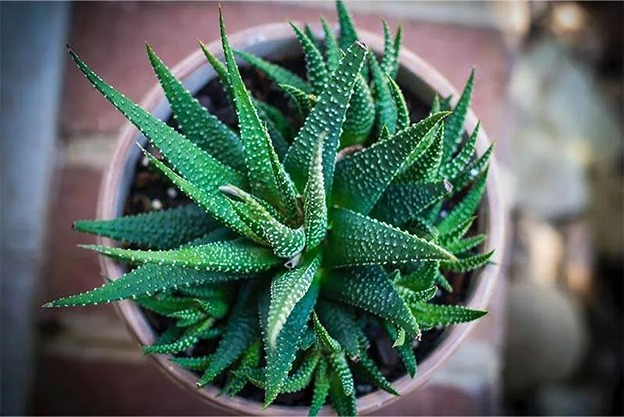
Common Pests & Issues
Aloe vera is generally a resilient plant and is not susceptible to many problems. However, there are a few common challenges to be aware of. The primary concern is overwatering, as it can result in root rot. To prevent this, ensure that the potting medium has good drainage and water the plant less frequently.
Mealybugs are the most prevalent insect pest affecting aloe vera. They appear as fluffy clusters and often hide within the plant’s central area. If you notice a mild infestation, you can address it by dabbing a cotton swab or small paintbrush dipped in rubbing alcohol directly onto the mealybugs. Another method is to use your fingernail to dislodge the insects and discard them. If the problem persists, you might need to resort to using an insecticide.
Regularly inspect your plants for signs of stress, pests, or disease symptoms. Identifying and treating these issues early on is easier and more effective in maintaining the health of your plants.
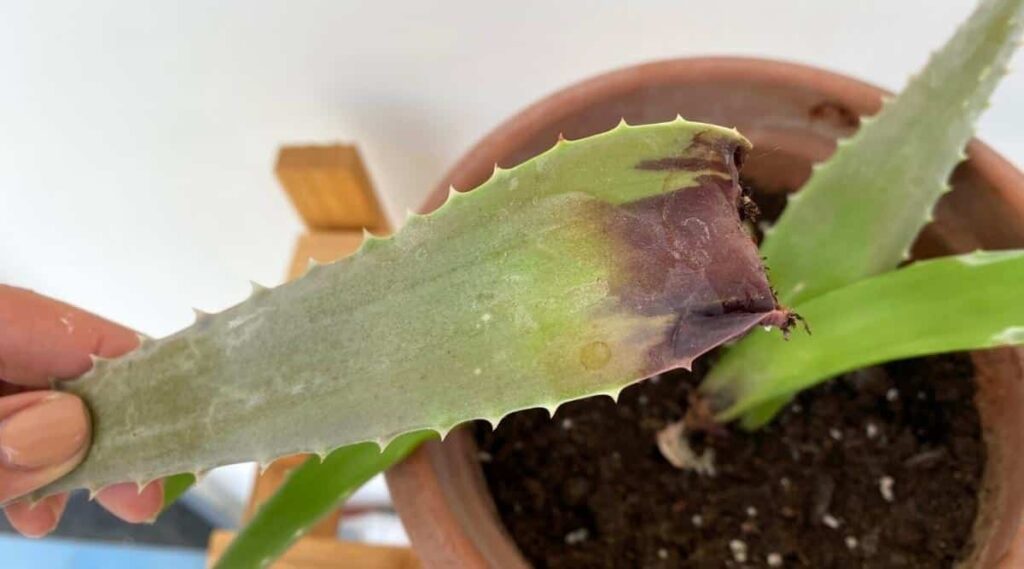
Harvesting Aloe Vera
Growing aloe vera at home offers the advantage of having a convenient source of cooling gel for minor injuries and burns. To utilize aloe vera’s soothing properties, follow these steps:
- Selecting a Leaf: Choose a mature leaf that is thick and plump from the aloe vera plant. Use a sharp knife or garden shears to cut the leaf at its base.
- Extracting the Gel: There are two methods to extract the gel. Firstly, you can squeeze a small amount of aloe vera gel directly from the cut end of the leaf. Alternatively, you can slice the leaf lengthwise, exposing the juicy gel inside. Gently squeeze the leaf to extract the gel.
- Storing or Applying: You can collect the gel in a small container for future use, ensuring it is properly sealed. Alternatively, if you require immediate relief for a burn, you can place the leaf, gel-side down, directly onto the affected area.
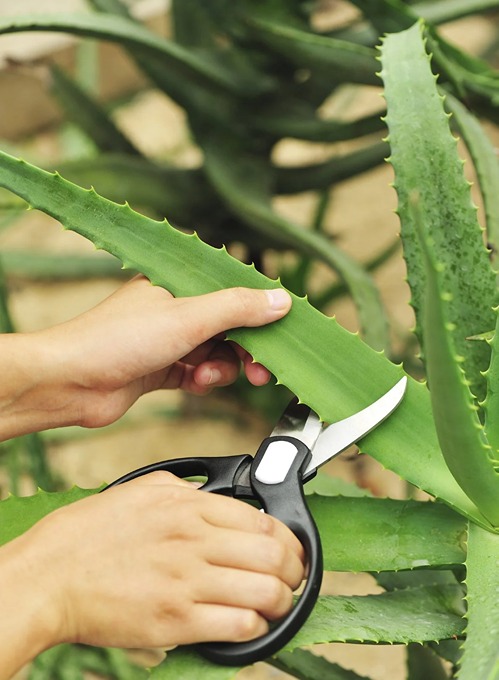
Benefits of Aloe Vera
Aloe vera offers a range of potential benefits. Here are some commonly recognized benefits of aloe vera:
- Skin Health: Aloe vera gel is often used topically to soothe and hydrate the skin. It may help with sunburn relief, moisturizing dry skin, reducing irritation, promoting wound healing, and addressing various skin conditions like acne, psoriasis, and eczema.
- Digestive Aid: Aloe vera juice or gel, when consumed orally, is believed to support digestive health. It may help with alleviating symptoms of acid reflux, soothing stomach ulcers, aiding digestion, and promoting regular bowel movements.
- Nutritional Content: Aloe vera contains vitamins, minerals, and antioxidants, including vitamins A, C, E, and B, as well as calcium, magnesium, and potassium. These nutrients can contribute to overall health and well-being.
- Immune Support: Aloe vera may have immune-boosting properties, thanks to its bioactive compounds like polysaccharides, which can help enhance the body’s natural defense mechanisms.
- Anti-Inflammatory Effects: Aloe vera is known for its anti-inflammatory properties, which can help reduce inflammation both externally and internally. It may provide relief for joint and muscle discomfort and contribute to overall inflammation management in the body.
- Oral Health: Aloe vera mouthwashes or gels may help with gum health, reducing plaque buildup, and soothing oral ulcers or canker sores.
- Antimicrobial Properties: Aloe vera contains substances that exhibit antimicrobial properties, which can help combat certain bacteria, fungi, and viruses.
